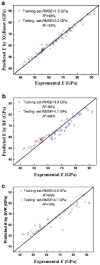Application of Machine Learning in Amorphous Alloys
- PMID: 40333423
- PMCID: PMC12029083
- DOI: 10.3390/ma18081771
Application of Machine Learning in Amorphous Alloys
Abstract
In the past few decades, traditional methods for developing amorphous alloys, such as empirical trial-and-error approaches and density functional theory (DFT)-based calculations, have enabled researchers to explore numerous amorphous alloy systems and investigate their properties. However, these methods are increasingly unable to meet the demands of modern research due to their long development cycles and low efficiency. In contrast, machine learning (ML) has gained widespread adoption in the design, analysis, and property prediction of amorphous alloys due to its advantages of low experimental cost, powerful performance, and short development cycles. This review focuses on four key applications of ML in amorphous alloys: (1) prediction of amorphous alloy phases, (2) prediction of amorphous composite phases, (3) prediction of glass-forming ability (GFA), and (4) prediction of material properties. Finally, we outline future directions for ML in materials science, including the development of more sophisticated models, integration with high-throughput experimentation, and the creation of standardized data-sharing platforms. These insights provide potential research directions and frameworks for subsequent studies in this field.
Keywords: amorphous alloys; glass-forming ability; machine learning; properties.
Conflict of interest statement
The authors declare no conflict of interest.
Figures


References
-
- Inoue A. Stabilization of metallic supercooled liquid and bulk amorphous alloys. Acta Mater. 2000;48:279–306. doi: 10.1016/S1359-6454(99)00300-6. - DOI
-
- Blyskun P., Maj P., Kowalczyk M., Latuch J., Kulik T. Relation of various GFA indicators to the critical diameter of Zr-based BMGs. J. Alloys Compd. 2015;625:13–17. doi: 10.1016/j.jallcom.2014.11.112. - DOI
-
- Qiao J., Jia H., Liaw P.K. Metallic glass matrix composites. Mater. Sci. Eng. R-Rep. 2016;100:1–69. doi: 10.1016/j.mser.2015.12.001. - DOI
-
- Samuel A.L. Some studies in machine learning using the game of checkers. IBM J. Res. Dev. 1959;3:210. doi: 10.1147/rd.33.0210. - DOI
-
- Ramprasad R., Batra R., Pilania G., Mannodi-Kanakkithodi A., Kim C. Machine learning in materials informatics: Recent applications and prospects. Npj Comput. Mater. 2017;3:54. doi: 10.1038/s41524-017-0056-5. - DOI
Publication types
Grants and funding
LinkOut - more resources
Full Text Sources
Miscellaneous

